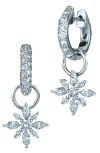The Big Name Game
February 03, 08
Admit it; hardly anyone watches the Oscars or the Emmys to see the awards being doled out (Best Lighting anyone?). No, we mostly watch because we love to see the pre-show action on the red carpet. While the viewers tune in for the entertainment value, for many companies, the red carpet can translate into lots of greenbacks. A celebrity who wears their product, and who gets a close up on E!, an interview with Joan or a write-up in the papers the following day can be worth millions to a firm. But just how do these products end up adorning the necks, arms and ears of the stars – and is it all it’s cracked up to be? IDEX Magazine Editor-in-Chief Danielle Max talks to three experts about the big name game.
When it comes to celebrity credentials, New York-based Kwiat has plenty to f lash around. The relationship with celebrities is part of the firm’s overall marketing approach; and it’s an approach that seems to be working. The company has dressed stars such as Terri Hatcher, Charlize Theron, Sharon Stone, Tom Cruise and Jessica Alba, and their pieces regularly make an appearance on the red carpet.
“The fashion world, especially when it comes to jewelry, is very celebrity focused,” says Greg Kwiat, a fourth generation member of the diamond family. “People look to celebrities as taste makers. When a celebrity wears our jewelry, it reflects positively on the piece and on the brand.”
Despite this positive endorsement, Kwiat admits that much of the benefit of luminaries wearing the brand is not tangible. Nevertheless, the company does see many indirect benefits from product placements on the red carpet. “The increased brand awareness and mentions in the press keeps us top of mind for consumers,” he says. In the case of Hal le Berry, who wore the company’s newly launched Kwiat Star Collection; Kwiat said that Berry’s endorsement of the line, and the media coverage focusing on one of the world’s most beautiful women, helped propel the collection into one of the company’s best sellers. “It was a real boon to us for her to wear it,” he says.

Despite the power that fame brings, not every headliner gets to strut their stuff in Kwiat. “Celebrities need to reflect the values of the brand,” he says, citing actress Natalie Portman as a perfect example of the classy and sophisticated “Kwiat woman.” Although he won’t name names, Kwiat does say that on occasion the company has been approached by celebrities wanting to wear their jewelry who did not adhere to the message that Kwiat conveys. “There have been occasions where we have respectfully declined to lend out our jewelry,” he says diplomatically.
How do the lucky few that the company believes embody the brand ideals end up wearing Kwiat to a high profile event? “There is no one simple way that a piece of jewelry ends up on the red carpet,” says Kwiat. “Sometimes, a celebrity will call us directly to borrow something. They have either seen a specific piece that they want to wear or just want to work with us in general. In other cases, it is through our relationship with stylists or celebrity assistants.”
Owing to their involvement in VIP events, like many luxury companies, Kwiat is especially in demand around the time of major award shows. The company works closely with stars to help them put their look together, sometimes beginning to work as much as a month in advance. Despite the best planning, it is not until the superstar actually steps out of the limousine and onto the red carpet that a company can know for sure that their jewelry has been picked. “Once, on the day of the Oscars I was at the home of the best actress nominee,” says Kwiat. “I had every expectation that she was going to wear our earrings, but when I saw her on television, she was wearing somebody else’s jewelry. I was very disappointed.”
If a celebrity isn’t contractually bound to wear a certain brand, then there will always be a guessing game of wondering if they will wear the goods. Rumors abound about celebs demanding the pieces that they wear as gifts or even requesting payment to wear a certain brand to a high profile event. Kwiat asserts that the company does not accede to such requests. “In the past, we have gifted celebrities who have worn our major pieces,” he says, “but we have never given them the piece itself. We might give them a smaller item as a thank you.”
As for aligning themselves with a celebrity brand ambassador, Kwiat admits that while that isn’t the direction the company is taking themselves at the moment; it isn’t something that can be ruled out altogether. “We don’t want to overpower the brand,” he says.
If you are a well known designer or manufacturer who works with platinum, chances are you’ve taken part in the Platinum Guild International (PGI) celebrity suites. At the three most focused upon celebrity events of the year – the Golden Globes, the Oscars and the Emmys – PGI sets up shop to offer celebs and their fashonista stylists the chance to choose the accessories that are going to accompany them down the red carpet.
As well as being a great venue for the celebrities to chose their pieces, Michael O’Connor, senior vice president of PGI, points out that the suites are also vehicles for getting new or unknown designers out into the public eye. He mentions Janet Weller, a designer from the UK who helped complete Stockard Channing’s outfit for the 2005 Emmy Awards. “It is,” he says, “a wonderful opportunity for smaller designers who would otherwise not have the ability to be seen in such a way.”
Such is the power of platinum that invitations to the PGI suite are strictly limited (it’s appointment only) and hotly contested over. The earlier a celebrity’s appointment, the better the choice of products they have to chose from. While refusing to mention any names, O’Connor says that one year two female celebrities jockeyed fiercely with each other over who received the coveted first appointment.
The fact that celebrities would take it so seriously is surprising. Even more remarkable is that it’s very often the stars themselves and not their stylists who attend. In fact, says O’Connor, some celebrities have been known to leave their stylists at home, preferring instead to use his specialized platinum knowledge to choose their red carpet-worthy piece. This is one of the factors about the suite that O’Connor plays up the freedom of celebrities to choose the designers and the pieces that speak to and represents them.
Unlike other celebrity gatherings, including the award events themselves, O’Connor insists that the PGI works very hard to make sure that the open house does not become a “swag suite” where attendees are given tons of free items. That’s not to say that there is not a certain amount of ‘treats’ going on at the suites. At the 2007 Golden Globes, guests received gift-bags valued at $1,700 and a spa service provided by a Beverly Hills spa. Similar experiences awaited visitors to the Academy and Emmy Awards suites later in the year.
O’Connor fiercely believes that paying a star to wear a particular item (he estimates red carpet product placements at between 3-5 percent) not only detracts from the value of the jewelry but it also denigrates the value of the brand. “It makes the impression that the piece was not worthy of being chosen on its own merits; that it had to be paid for.”

Like Kwiat, though, he sees nothing amiss with gifting a celebrity to thank them for choosing a certain company. “There’s nothing wrong with thanking a celebrity for wearing a brand. If they particularly liked it, it’s great that the celebrity now owns a piece of that brand. It keeps them top of mind,” he says. The debate over whether or not to pay a celebrity is fine if you are a well-known name, but how’s a smaller brand to get their jewelry noticed in the first place? Michelle Orman is an expert in the field of fine jewelry product placements is. Along with Jessica Cohen, she founded Lüp Publ ic Relations, a New York-based full service PR, marketing and product placements company, and she knows all about getting products into the spotlight.
Although it is always good to think big, one of the best ways to get into the media glare is to start a little bit smaller. Instead of aiming for the Oscars, Orman, who has placed jewelry on TV series such as Sex and the City and movies including How to Lose a Guy in 10 Days and The Pink Panther suggests starting off with television, film or print media placements.
A word of encouragement: If you think the small screen is too small, think about the famous Carrie necklace, which featured heavily in Sex and the City and spawned a glut of copycats. Or, sticking with HBO’s mega-hit, how about Sol Raphael’s diamond, gold and emerald “Wendy” necklace, which Sarah Jessica Parker wore during the sixth episode of the show and which received a great deal of coverage on fan sites and message boards?
The service of intermediaries, such as a product placement company, is often necessary because of the difficulty in building celebrity relationships. Getting a celebrity to wear a specific company’s jewelry is never a quick process and can take a long time to form a relationship, if not with the celebrity themselves, then with the star’s people. “These are relationships that need nurturing over a long period,” says Orman.
In a practical attempt to make the connection between designers and the media easier to negotiate, Lüp took their business online with the launch of luprocks.com. Using the site, which showcases a wide variety of fine jewelry, watch and accessory designers, creative designers or editors can get in touch with companies directly. “We’ve had a lot of good feedback about people getting products placed,” says Orman. “We have been involved in some of those placements, but in others we’ve simply heard back from particular companies whose products have been used on TV or in magazines.”
Although, Orman concedes that some jewelry designers are lucky enough to get discovered with very little effort, for most it’s a matter of making the effort to get their name out there by whatever means possible. One of the ways to do this, for those wary of hiring a product placement company, says Orman, is to buy a list with the contact details for various stylists. These, she says, are easily available and you simply approach them in the same way that you would an editor of a magazine and hope your product is needed.
Once your products do begin to get some media exposure, whether on television or in print, Orman recommends making the most of it. “Write on your website ‘as seen on…,’ or put it on your marketing materials,” she says. “Do everything you can to derive the most benefit from the experience.”